What to do with sprouted onions?
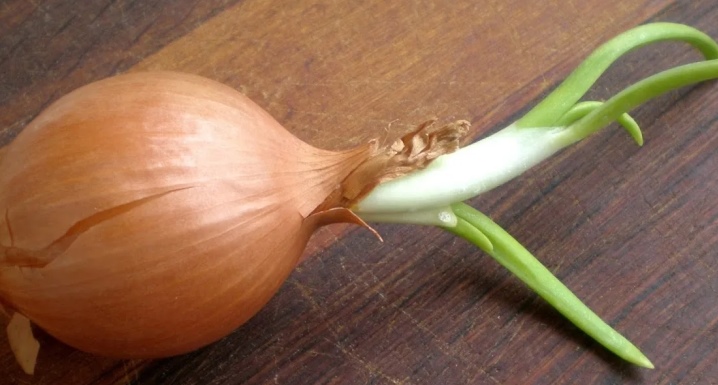
Many summer residents keep onions at home until spring, so that they can be planted in the beds with the onset of heat. However, the seedlings often begin to sprout. You can read about the reasons for this phenomenon and what should be the actions of gardeners in the article.
Germination reasons
Sprouted sevok is a fairly common phenomenon that frightens novice summer residents. The bulbs, which are supposed to be at rest, wake up, and therefore begin to grow. This can happen for several reasons. The most common is the onset of spring. Nothing can be done here, the onion will sprout, because it is so laid down by nature. However, it can sprout even if the winter is too long.
The second reason is storing vegetables in a damp and poorly ventilated area. In such conditions, the seedlings may well begin to germinate long before planting. And if its neck also contains moisture (for example, the material was originally stored incorrectly), then germination cannot be avoided completely.
Sprouted bulbs should be carefully examined. If excessive moisture has led not only to sprouts, but also to mold, such specimens should be thrown away immediately. Planting them or hoping for a miracle, keeping them further, is inappropriate. You can tell if the onion is moldy by squeezing it lightly. The vegetable will be soft, unpleasant to the touch, and a putrid smell will appear after squeezing.
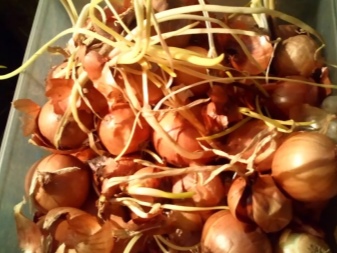

How do I pause a process?
First of all, gardeners should find out what to do so that the seedlings do not start sprouting at all. All that is needed is to organize the storage area correctly. This should be a room with a temperature regime of 18 to 24 degrees Celsius. The permissible humidity ranges from 50-70 percent, if it is higher, the decay process will start. To prevent the onion from drying, you should take the husk from the usual onion and sprinkle it on the sets. In addition, it is worth putting buckets of ash in the room. Only well-established ventilation will allow air circulation.
If the seed has already begun to sprout, nothing can be done about it. It is impossible to stop growth that has already started, the only option is to germinate further. For this purpose, you need to use special containers for planting onions or egg containers, from which the bottoms are cut off where the eggs were. Next, the containers are placed on pallets and filled with water a little.
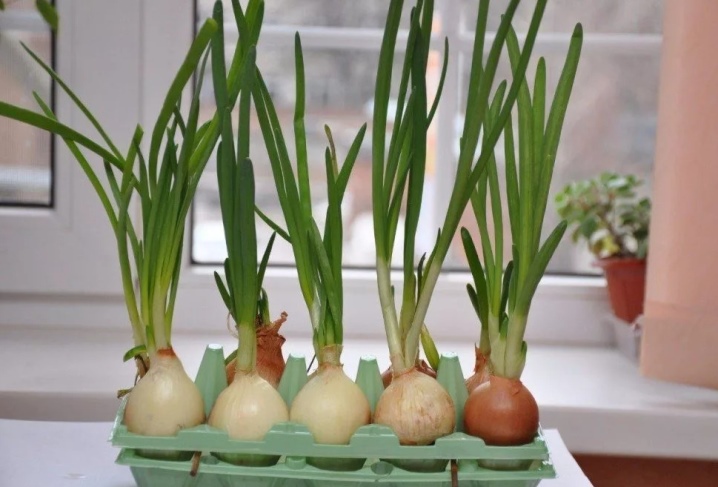
If this is a special container, it will be impossible to make a mistake with the amount of liquid: there is a level mark there. Then the bulbs are immersed in the holes, but so that there are only roots in the water. Otherwise, the vegetable will rot in a couple of days. The sprouting onion does not need to be fed with anything. The only thing is that you have to change the water every day. Thus, it will turn out to get at least feathers so as not to throw away raw materials. They will be even more juicy if you saturate the water with oxygen using an aerator from an aquarium.
You can also sprout onions if you use plastic canisters from under the water. The bottles are filled with wet soil, then many round holes are cut into them. The bulbs are inserted there so that the sprouts are on the outside. Bottles are placed on the windowsill and kept at the desired humidity. Thanks to this method, it is possible to save highly germinated bulbs, using them as fresh herbs.

Is it possible to plant and how to do it?
If the onion has begun to sprout, this is not yet a reason for panic. After all, some specimens can be planted in the ground, like a standard plant without a sprout. However, it will not always be possible to do this.
- Seed onions, which have just begun to sprout, have every chance of growing into a healthy and useful plant. If early spring has come, then you will have to carry out an unplanned planting in the ground until the sprouts become too long.
- In the presence of a large sprout, onion culture cannot be obtained. However, you can always plant such onions on greens. Before planting in the ground, the sprout is removed from the vegetable.
- If the sprout is too large and at the same time the bulb itself has dried up, it is absolutely useless to plant it in open ground. Such vegetables will not yield a harvest.
You can plant bulbs both at home and in the garden. Let's consider both options.
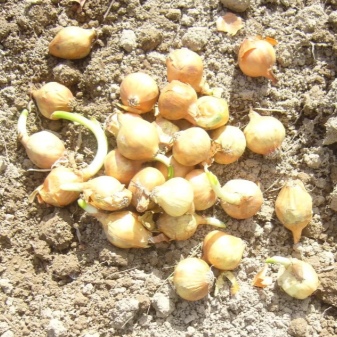
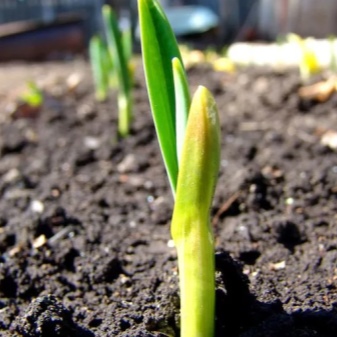
Home cultivation
The first step is to select a suitable container and make holes on its bottom to drain water. Then drainage is placed on the bottom (you can use expanded clay, broken brick, small pebbles) with a layer of 2 centimeters. The disinfected substrate is poured into the container. If it is store-bought soil, it is usually not disinfected.
The bulbs are sorted. The husks are removed from them, and then checked for rot and mold. Defective copies are subject to rejection.
The next stage is landing. Vegetables are placed in the ground, very closely, since the onions will not grow in the soil, but, on the contrary, dry (this happens if the vegetables are planted out of season). The planted bulbs are covered with earth, but a third of them should rise above the ground level.
To keep the greens juicy, containers with bulbs are taken out in a cool place with low light for 7 days. After this time, they are placed on warm windowsills. The room temperature should not be lower than +20 degrees. If the sun is shining strongly, the containers need to be pasted over with foil around the perimeter.
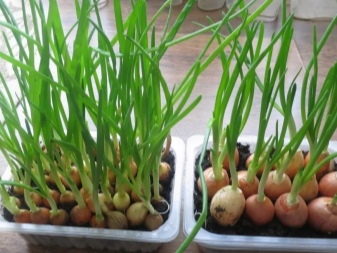
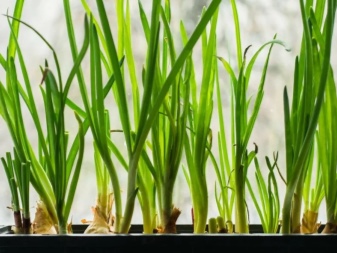
Watering should not be frequent. Top dressing onions is not needed, but the appearance of greenery can be accelerated if the plantings are spilled with a solution of wood ash every 14 days. You will need 5 grams of the substance per liter of water.
Landing in open ground
First of all, the onion is sprouted a little, soaking its roots in liquid. It will not be superfluous to add root growth stimulants to the water. The depth of the beds in the garden should be at least 5 centimeters, since the bulb should go deep into the ground by 3 cm.The distance between the bulbs is 10 cm, and the distance between the bulbs is 25 cm.The sprouting sprout is cut off completely, but the roots are not touched in any case, because this way the plant dies one hundred percent.

Useful Tips
Finally, we will analyze a few good tips from experienced gardeners.
- If the goal is to grow exactly onion vegetables, abundant greens should not be allowed. It will draw out all the nutrients, and the turnip simply will not ripen. Therefore, the feathers must be removed. It is worth considering: if the pen is cut off, then after a couple of days it will recover and will be the same as before it was removed. But if you remove it with scissors, then it will no longer grow back.
- When growing onions on a turnip, you must not allow them to shoot arrows. You need to do the following: put the bulbs in cheesecloth, tied and dipped in hot (85-90 degrees) water for a couple of seconds. The vegetables are then immediately immersed in cold water. They are thoroughly dried and then planted.
- If the onion has begun to sprout, it may rot after planting. To prevent this from happening, you need to make a dark pink manganese solution. The sevok is placed there for 120 minutes. Then it is washed in cool water, dried and planted on the garden bed.
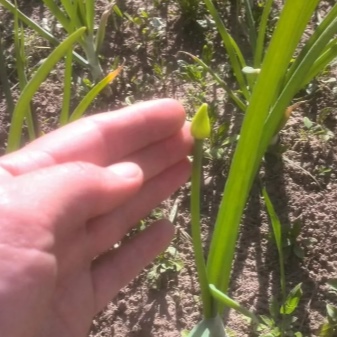
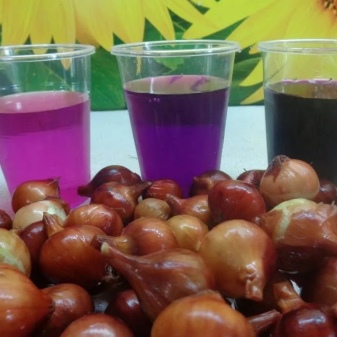













The comment was sent successfully.